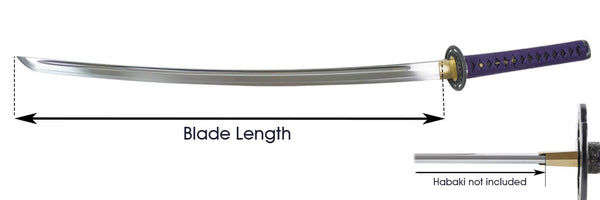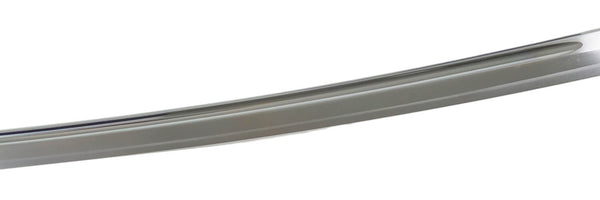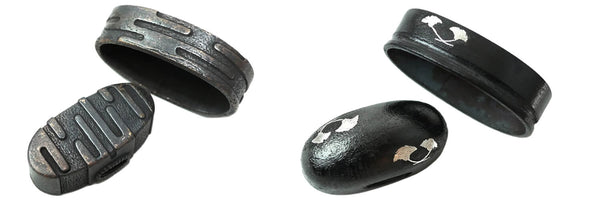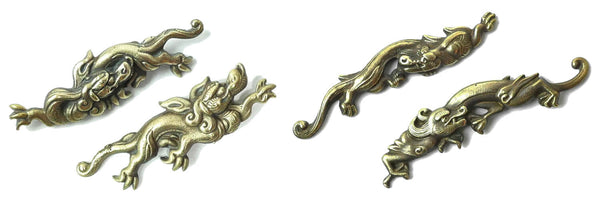-
Japanese Wooden Weapons Craftsmanship, the Beginning of the End | In addition to the structural crisis affecting the industry, in 2019, the closure of one of the largest Japanese workshops, Horinouchi, then, in 2020, the covid crisis have for consequences a drastic increase in prices and production times, and mid-term, a probable disappearance of the manufacture of wooden weapons in Japan. To learn more, you can read our article detailing the situation and the measures taken to help this industry. -
Review Reward Campaign | Leave a comment on your recent purchase and receive a 5% discount.
How to choose your Iaito
Information on choosing your Iaito Size, Model & Options
A non-disclosed agreement between a key player in the industry and the Jisei brand (Murayama Token workshop) resulted in the termination of our relationship with the workshop. Accordingly, Seido has removed all Jisei products from its catalog, except inStock products, which will be discontinued once out of stock. We invite you to consult our blog article for more information on this situation: History of our collaboration with the Murayama Token Workshop (Jisei brand)
Unlike Dogi, Hakama or Obi, the use of poor quality materials to manufacture Iaito can be dangerous and lead to serious injuries. Seido is very attentive to safety and our Iaito are especially selected for their high quality.
Contrary to a popular belief in the West, steel Iaito do not exist in Japan. The possession of weapons is strictly prohibited by law and owning a steel weapon is only possible with a legal circumvention that categorizes the Katana as an object of art, not as a weapon. Because of this very restrictive law, the vast majority of practitioners tends to use Iaito, even those owning a real and expensive steel Katana. Iaito are usually made of aluminum/zinc alloys, which can be produced via different processes. Minosaka blades are manufactured through a proprietary process that yields a high quality, "bubble-free" alloy.
The first thing to determine when choosing a Iaito is your type of practice. Will you use your Iaito only from time to time? Do you use it in every class? What type of Budo do you practice?
Beginners and casual practitioners will opt for low-cost but reliable materials. Those can be found in the Tokusei or Jidai models by Minosaka. More seasoned practitioners and collectors will opt for superior models with a better finnish. High level practitioners will appreciate heavy-weight (large blade) models such as the Hon Koshirae. Please note that heavier Iaito, which are balanced toward the kissaki (tip) are difficult to handle. They should be reserved for experienced practitioners.
The purpose of this guide is to give you an overall presentation of possible customizations. Details about each possible option, depending on whether or not it is available for a specific model, can be found on each Iaito’s product page.
In those countries, customs are very strict about weapon importation (which includes Iaito). We discourage placing an order without pre-approval from your local customs and we will not assume responsibility for those packages.
Contents
The weight of a Iaito depends on the blade, Tsuka length, and options
How to determine the correct size
The blade length is measured in a Japanese traditional unit called Shaku. One Shaku equals 30.3 cm, or roughly 1 feet (0.994 Ft.). Its subunit is the "Sun". There are ten "Sun" in one "Shaku", so 5 Sun can also be written 0.5 Shaku. Note that the length of a blade does not include the Habaki (see pictures), but is measured in a straight line from the tip (Kissaki) to what is called the Munemachi (base of the blade), hidden under and covered by the Habaki.
The blade length is usually determined by the size of the practitioner.
Be careful though: depending on schools and teachers, the recommendations may vary slightly from what we suggest in this table. In general, for Aikido practitioners for whom the Noto (sheathing of the sword) does not seem crucial, we advise to choose a Iaito 0.5 Shaku shorter than what is suggested on the table.
The blade length is given according to the size of the practitioner and following the guidelines suggested by the Japanese Iaido Federation. The Tsuka lengths are suggested by our team so as to preserve the balance of the weapon, but it also takes into account the fact that the hands of western practitioners are generally bigger than those of the Japanese.
If you are a beginner, you can stop here, you do not need any other information to choose your Iaito.
The following table does not take into account the weight variations that occur when choosing Tsuba and Menuki.
Blade Length, Tsuka Length, Size Table & Weight
| Height (men/women) |
Recommended Blade length |
Recommended Tsuka length |
Standard Weight |
Heavyweight Weight |
|---|---|---|---|---|
| 150 cm / 155 cm | 2.20 Shaku (66.6 cm) | 7.5 ~ 8 Sun (22.7 ~ 24.3 cm) | ~780 g | ~900 g |
| 155 cm / 160 cm | 2.25 Shaku (68.2 cm) | 7.5 ~ 8 Sun (22.7 ~ 24.3 cm) | ~790 g | ~915 g |
| 160 cm / 165 cm | 2.30 Shaku (69.6 cm) | 8 ~ 8.5 Sun (24.3 ~ 25.6 cm) | ~800 g | ~930 g |
| 165 cm / 170 cm | 2.35 Shaku (71.2 cm) | 8 ~ 8.5 Sun (24.3 ~ 25.6 cm) | ~810 g | ~945 g |
| 170 cm / 175 cm | 2.40 Shaku (72.7 cm) | 8.5 ~ 9 Sun (25.6 ~ 27.3 cm) | ~820 g | ~960 g |
| 175 cm / 180 cm | 2.45 Shaku (74.2 cm) | 8.5 ~ 9 Sun (25.6 ~ 27.3 cm) | ~830 g | ~975 g |
| 180 cm / 185 cm | 2.50 Shaku (75.8 cm) | 9 ~ 9.5 Sun (27.3 ~ 28.8 cm) | ~845 g | ~990 g |
| 185 cm / 190 cm | 2.55 Shaku (77.3 cm) | 9 ~ 9.5 Sun (27.3 ~ 28.8 cm) | ~860 g | ~1010 g |
| 190 cm / 195 cm | 2.60 Shaku (78.8 cm) | 9.5 ~ 10 Sun (28.8 ~ 30.3 cm) | NA | ~1030 g |
| 195 cm+ | 2.70 Shaku (81.8 cm) | 9.5 ~ 10 Sun (28.8 ~ 30.3 cm) | NA | ~1050 g |
Standard weight blades have a maximum of 2.55 shaku.
Heavy blades a maximum of 2.70 shaku.
More information on available options
Click on the "open" buttons to display the details.
Blade Hamon
The Hamon on the Iaito is for purely aesthetic reasons and has no effect on the usage of the weapon.
On Shinken (Katana), it results from selective quenching, and its quality depends heavily on the forge.
The Iaito being made of aluminum, it cannot be sharpened, the Hamon is made by sanding it using a stencil. In the same category of Hamon (e.g. Notare, Midare), the workshop has dozens of stencils, all slightly varying, so that there are very few identical Hamon.




Blade Groove (Hi or Bo-hi)
Habaki & Seppa
The habaki is the piece of metal circling the base of the blade. It has the two main purposes, locking the tsuba in place, maintaining the sword in the Saya. Unlike Shinken Habaki, that can be incredibly expensive, Iaito Habaki are standardized and gently forced in place. This means that it is not recommended to remove/change the Habaki on a Iaito blade.
The seppa are washers used in front and behind the tsuba to tighten the fittings, made of copper. They are mandatory to keep the Tsuba in place securely.
Minosaka offers 3 different models: Muji (plain), Shonai, and Yujo, that are available in brass finish, gold plated finish or silver plated finish. The Seppa are available in bronze, raw brass, gold plated and silver plated finishes.




Tsuba
The Tsuba has two main functions: aesthetic and balance adjustment.
A heavy Tsuba shifts the balance towards the Tsuka, making the Iaito easier to handle whereas a light Tsuba will push the balance towards the Kissaki (choose the latter if you decide to focus on cutting training).
Tsuba are usually made of Iron, sometimes stainless steel, with different finishes.
Minosaka offers 19 models to chose from, for all Minosaka models.
Tsukasame
The Samekawa or "shark skin" is the part under the Tsukaito. Despite being called a "samekawa", and because shark hunting isn't really a thing nowadays, stingray skin is used instead. Its main purpose is to keep the Tsukaito in place and to reinforce the Tsuka structure. The same is sanded and polished in order to produce a durable high quality type of leather. On live blades (Shinken) mount, the Same is a "maki same", wrapper around the Tsuka wood. However, for cost reasons, Iaito Tsuka are made with two rectangular pieces of same embedded in the Tsuka. This is called Tanzaku-same. The Maki-same option is possible on Minosaka Iaito on request.
Same exist in different quality and type.
Minosaka offers both classic white and black finishes.

Fuchi & Kashira
The Fuchi is a hilt collar between the tsuka and the tsuba. It serves as a reinforcment for the Tsuka (handle). The tang of the sword goes into the tsuka through the opening in the fuchi.
The Kashira is a pommel on the end of the tsuka, which serves, similarly to the Fuchi, as reinforcement for the Tsuka (handle). It usually features a hole that is used to secure the tsukaito (wrapping). Some kashira, and notably Suigyu (water buffalo) made Kashira do not have a hole, which forces to slightly change how the maki (wrapping) is done.
Minosaka's Koshirae (models) are based on the Fuchi and Kashira featured. Minosaka does not offer full custom workshop, so fuchi and Kashira modification is therefore not possible.
All Fuchi/Kashira are available as standalone products and all technical information for each Fuchi/Kashira is detailed on each product page.
Tsukaito (wrapping)
The Tsukaito has two main purposes: it serves as a grip and it holds the Tsuka tightly together. A tightly wrapped Tsuka is extremely important for security.
Cotton allows a better absorbtion of the sweat but is less durable than silk and leather. It is the standard option on most Iaito. Silk feels a little harder and may not be recommended for beginners but has a significantly longer lifespan. Leather does not absorbs sweat but offers an excellent grip and is the most durable material. Leather is available in standard and suede version (napped finish). The latter has a slightly better grip, it keeps dye better and is therefore available in more colors than standard leather; it is, however, slightly less durable.
Minosaka offer cotton, silk and leather Tsukaito.
Sayanuri (lacquer)
The Saya is made of two piece of Japanese magnolia wood that are glued together. It is reinforced by both the Sayajiri (end of the Saya), the Koiguchi, and of course, the lacquer. For cost reasons, unlike Shinken, the lacquer of Saya for Iaito are not made from traditional Urushi lacquer but from modern urethane lacquer.
Saya lacquers are usually separated into 4 groups: "classical lacquers", "Kawari-nuri" for combinations (multiple lacquers used on the same Saya), "Kizami" for lacquers applied on a modified Saya (e.g. Saya with shapes carved into the wood) and "Maki" for Saya partly wrapped in another material (such as shark skin or wicker). Kawari-nuri cannot be combined with Maki or Kizami. Each available option is detailed on product pages.
The Kurikata is the piece placed 7.5 cm from the Koiguchi (Saya hole) on the Omote side of the Saya, used to nest the Sageo. It is possible to move the Kurikata on request for all models (see product options).

Kojiri
The Sayajiri (saya butt) is usually finished with buffalo horn (synthetic material in the case of Iaito), but it is possible to replace the buffalo horn by a piece of metal called a Kojiri, which significantly reinforces the Saya.
The classic shape of traditional Shinken Saya is slightly narrower at the end than at the koiguchi. It is therefore recommend to select a Kojiri that is slightly smaller than the fuchi. Kojiri are very often made from the same design as the fuchi and kashira.
Minosaka does not offer any Kojiri option. However, three models have a Kojiri "by default" on their Koshirae: Toppei Koshirae, Shinto Higo Koshirae and Tensho Koshirae.
Sageo
The Sageo, the braided cord that comes on the Saya kurikata, has two main purposes; it is tied to the Obi (belt) to prevent the Saya from falling when the sword is with its owner, and it has an ornemental purpose when the sword is displayed. Some Koryu also teach how to use the Sageo as a weapon or to tie an opponent's hands (hojujutsu). It is also said that the cord serves as a spiritual bond between the samurai and the sword.
Minosaka offers classic cotton and silk Sageo as well as a check pattern cotton model.
Taking care of your Iaito
Unlike steel Shinken (Katana), Iaito require only minimal maintenance. It is not absolutely necessary to oil the blade because it does not rust. However, regularly applying oil is advised to feed the wood of the Saya.
Please be careful to not use Uchiko powder (used for Shinken) as it may cause damage to alloy blades.
Of course, the Iaito should be cleaned with a cloth after each class. Ensuring good maintenance of all parts is essential to keep the Iaito in good condition, to avoid safety issues and hence, injuries.




